Solar mini-module with perovskite solar cells
Project Director: Dr. Lucia LEONAT
Summary
Over the past decade, a new generation of solar cells arise remarkably, the hybrid perovskite solar cells (HPSCs, or simply PSCs). They cumulate exceptional intrinsic photophysical properties with manufacturing versatility and low-cost precursors materials, therefore presenting a huge potential for large-area production on an industrial scale.
This project, brings previous research conducted by our group, in the field of perovskite solar cells, closer to commercial applications by fabricating large-area perovskite solar cells and integrating them into functional solar modules. The Solar-PVK project aims to develop efficient, large-area PSCs, with an active area exceeding 1 square cm, using low-cost solution deposition technologies. These devices will be connected together and encapsulated in a sealing box fabricated in-house, to assemble a prototype of a functional solar module. This solar module will be integrated into a solar portable charger, able to power for example a mobile phone, capable of supplying enough energy, in case of emergency situations or off-grid low power applications.
1. PhD Lucia Leonat (CS II)
2. PhD. Ioana Pintilie (CS I)
3. PhD Viorica Stancu (CS III)
4. Andrei Tomulescu (ACS)
5. Eng. Vasilica Toma (Tehnician)
6. Eng Gabriel Dobrescu (Tehnician)
7. Eng. Mihai Cioca (Tehnician)
8. Eng. Adelina Ighigeanu (Tehnician)
Dissemination
- "20th International Balkan Workshop on Applied Physics- IBWAP2022", 11-16 July 2022, Constanța, Romania, L. Leonat's talk, entitled "Hybrid perovskite solar cells - Improving the stability through compositional engineering", authors: L. N. Leonat, V. Stancu, A.G. Tomulescu, V. Toma, , A.C. Galca, S. Derbali, C. Besleaga, M. Florea, I. Pintilie.
- "20th International Balkan Workshop on Applied Physics- IBWAP2022", 11-16 July 2022, Constanța Romania, poster presentation of the "Triple Cation Mixed Halide Perovskite and SnO2 Mesoporous Scaffold For Solar Cells", authors: V. Stancu, L. N. Leonat, A.G. Tomulescu, A.C. Galca, C. Besleaga, V. Toma, S. Derbali, L. Balescu, M. Florea, I. Pintilie.
- "20th International Balkan Workshop on Applied Physics- IBWAP2022", 11-16 July 2022, Constanța, Romania, A.G. Tomulescu's talk, entitled "Partial substitution with imidazolium in hybrid perovskite solar cells for stability improvement", authors: A.G. Tomulescu, L. N. Leonat, F. Neatu, V. Stancu, V. Toma, S. Derbali, S. Neatu, A.M. Rostas, C. Besleaga, R. Patru, M. Florea, I. Pintilie.
- “International Conference on the Science and Technology of Synthetic Metals - ICSM 2022”, 17-22 July 2022, at the University of Glasgow, Scotland, poster presentation of the “Perovskite solar cells - From small to large area”, authors L. N. Leonat, V. Stancu, A.G. Tomulescu, V. Toma, I. Pintilie.
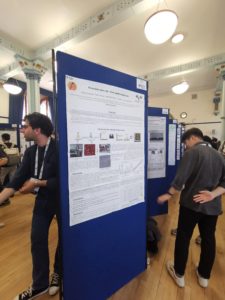
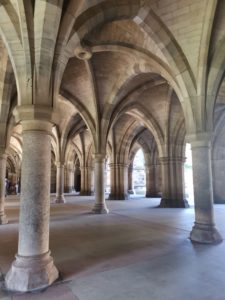

5. International Conference „E-MRS Fall 2021” , 21 - 23 September 2021, on-line participation with a poster, “Perovskite solar cells fabricated by spray coating and doctor-blade in ambient conditions”, authors L. N. Leonat, V. Stancu, A.G. Tomulescu, I. Pintilie.
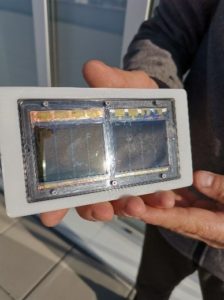
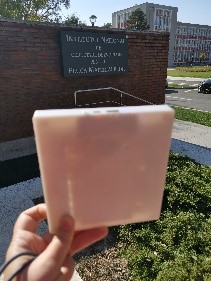
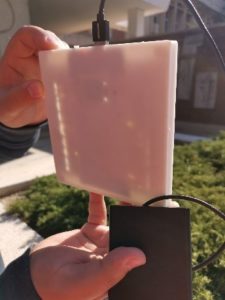

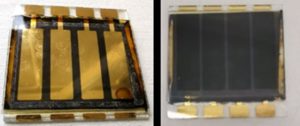
At stage II of the project, a slot-die/ dr. blade thin film deposition system was assembled (in-house), installed, and tested. With it, we fabricated thin films of perovskite and h-type layers for solar cells with a large active area, of over 2.4 square cm, with a power conversion efficiency of 4%.
Especially for these types of cells, upper electrode deposition masks and a cell contacting device for measurement were manufactured.
At stage III of the project, one of the main achievements obtained within the project is the modules, each containing 4 large area solar cells with hybrid perovskite, each cell of 2.4 cm² active area, with a unique design that allows the encapsulation of the entire active surface of the module. Their manufacture was carried out using large-area deposition techniques, compatible with those used in industry, such as spraying and blade deposition (slot-die). These modules represent the basic parts of a solar charger. Using the encapsulated modules, two solar chargers were fabricated and tested and operated with 2 or 4 modules.
This type of encapsulated perovskite solar mini-module was awarded the gold medal at EUROINVENT 2023.
- H. Mehdi, L. N. Leonat (corresponding author)*, V. Stancu, H. Saidi, M. Enculescu, A.G. Tomulescu, V. Toma, I. Pintilie, A. Bouazizi, A. C. Galca, "Effect of chlorine and bromine on the perovskite crystal growth in mesoscopic heterojunction photovoltaic device", Materials Science in Semiconductor Processing 143 (2022) 106558, (Impact Factor 4.644).
"Hybrid perovskite-based mini-solar module and corresponding encapsulation method", authors: L. N. LEONAT, A.-G. TOMULESCU, G. DOBRESCU, A. IGHIGEANU, M. LAZĂR, V. STANCU, V. TOMA, A/00625 from 12.10.2022.
Final results of the project
The main objective of the project was the development of perovskite solar cells with an active surface of more than 1 cm2, using low-cost solution deposition technologies, cells that can be integrated into a functional solar module prototype, capable of powering a mobile solar phone charger.
One of the achievements obtained within the project is the solar modules with 4 cells with hybrid perovskite of 2.4 cm2 active area, with a unique design that allows the encapsulation of the entire active surface of the module. Their manufacture was carried out using large-area deposition techniques, compatible with those used in industry, such as spraying and blade-assisted deposition (slot-die). These modules represent the basic parts of a solar charger, as the final goal of the project. The solar charger can work with 2 or 4 solar modules.
The perovskite cell solar charger has great application potential due to the fact that it can power mobile devices and reduce dependence on the electrical grid, promoting mobility.
Patent application "Hybrid perovskite-based mini-solar module and corresponding encapsulation method", authors: L. N. LEONAT, A.-G. TOMULESCU, G. DOBRESCU, A. IGHIGEANU, M. LAZĂR, V. STANCU, V. TOMA, A/00625 from 12.10.2022.
lucia.leonat@infim.ro
PROJECTS/ NATIONAL PROJECTS
Copyright © 2025 National Institute of Materials Physics. All Rights Reserved